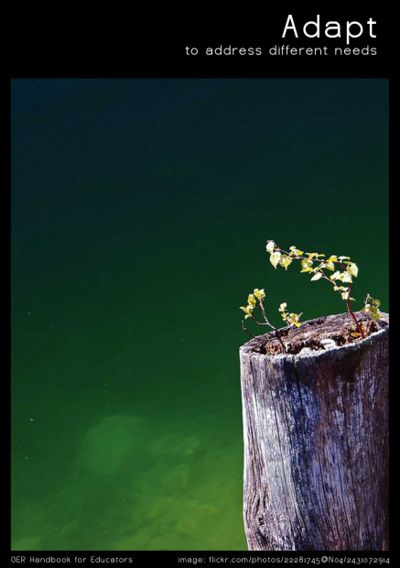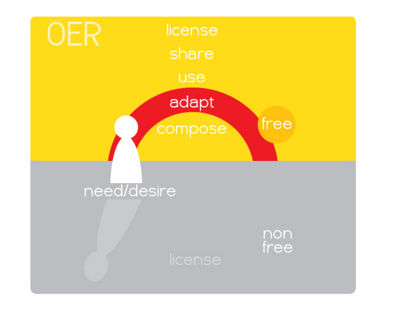Adapt
| OER Handbook for educators | |
|---|---|
| Contents | | Introduction | Find | Compose | Adapt | Use | Share | License | Conclusion | Appendices |
- Quality
- OER Translation
- Offline Versions
- Preferred Formats (may be deprecated)
- Accessibility
- Perspectives
- Revise and Remix OER
Adapting OER includes inserting and removing components, changing the sequence of learning activities, editing and remixing images, text, audio and video, etc. to suit the style of the educator and match the requirements of the learners.
Reasons to adapt an OER include:
- To address a particular teaching style or learning style
- To adapt for a different grade level
- To adapt for a different discipline
- To adjust for a different learning environment
- To address diversity needs
- To address a cultural preference
- To support a specific pedagogical need
- To address either a school or a district’s standardized curriculum
(ISKME, 2008)
Examples
- A teacher translates a web page about Queen Elizabeth from English to French.
- A teacher replaces pictures depicting Russian children working on a water project with images that are more familiar to her students in Ghana.
- A teacher changes some wording in a fourth grade unit on spaceflight to make it better suited for his third grade students.
Localization
This handbook emphasizes "localization": adapting an OER for a specific locale including translation, modifying the formats of dates and currencies, and recontextualizing the OER to be more meaningful for the learners in the local context. The context may be as different as a classroom on another continent, or as similar as another class in the same school.
Internationalization
Localization (l10n) goes hand-in-hand with internationalization (i18n). Whereas l10n is concerned with you adapting OER for your local context, i18n is concerned with preparing OER for adaptation by others in multiple locales.
As you look at your materials for possible OER, consider what adaptation would need to take place for teachers in other classrooms. Then, ask yourself if these materials need to be changed to reduce the amount of time other teachers would need to adapt the material for their classrooms.
Questions to think about:
|
These questions for self-reflection are not meant to advocate that all possible OER should remove any sort of local "flavor" from it. In fact, in some cases it's better to leave elements intact, because they can make the OER more interesting and exciting. Additionally, you should not try to make an OER applicable to every possible use. Such OER would likely be useless to most people because they would be too vague.
As you review the answers to your questions above, consider the following:
|
Adjusting the amount of adaptation in your own materials as you prepare them to become OER is a matter of balance. You should include information that is relevant, familiar and engaging to your learners, but structure the OER in such a way that replacing these context-sensitive items is easy for the next teacher downstream. One of the difficulties in addressing these issues is that you can never tell exactly who will use your materials. The most helpful advice that can be given is to carefully review your material and use your own judgment. As a teacher you know the requirements of the classroom best, and should be able to decide best how to make a resource useful to other teachers.
Source
ISKME. (2008, February 8). What is localization? Connexions. Retrieved March 21, 2008, from http://cnx.org/content/m15222/latest/

